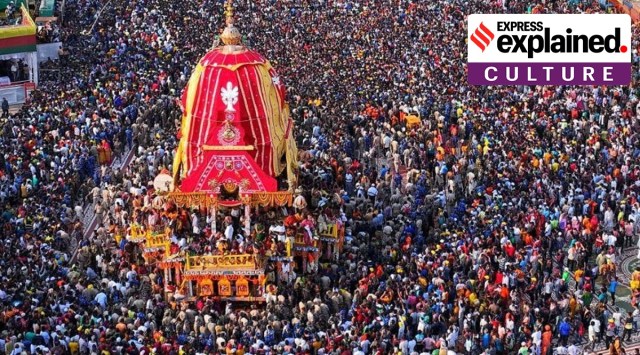Millions of visitors from across the globe throng the beach town of Puri in Odisha to take part in the annual Rath Yatra (car festival) of Lord Jagannath, which this year began on June 20.
According to Hindu mythology, the Lord along with his siblings — elder brother Lord Balabhadra and sister Devi Subhadra — embarks on a nine-day annual sojourn to his birthplace. The idols are taken to the Gundicha Temple, where they stay till the ‘Bahuda Yatra’ (returning car festival), scheduled on June 28 this time.

Significance of the Rath Yatra
The Rath Yatra takes place on the second day of the Odia month of Ashadha Shukla Tithi (bright fortnight) every year to commemorate the journey of Lord Jagannath and his two siblings from their abode —the 12th century Jagannath Temple, to the Gundicha Temple, believed to be their aunt’s home. Goddess Ardhasini, also known as Mausima, is believed to be the deities’ aunt.
The deities board three huge decorated chariots following the Pahandi ritual (ceremonial procession), before marching for around 3 km to the Gundicha Temple. Millions of devotees pull the chariots on the Bada Danda (Grand Road) of Puri town.
It is also believed that as non-Hindus are not allowed to enter the Jagannath temple, Lord Jagannath, believed to be the Lord of the Universe, steps out of his sanctum sanctorum during Rath Yatra to meet all his devotees.
About the three chariots
The three chariots — Taladhwaja Rath for Lord Balabhadra, the Darpadalan Rath for Goddess Subhadra, and the Nandighosa Rath for Lord Jagannath, have their own colours, height, diameter, wooden horses, guardian deities and even charioteers. They are made from the wood of locally available trees. Over 150 carpenters, labourers, woodcarvers, artists, and painters work for around 12 hours a day from Akshaya Tritiya onwards, nearly two months before the much-awaited event, to shape the chariots.
These workers call working on the chariots “hereditary service”. They don’t have any formal training in woodcarving or using modern machinery or equipment but rely on what they have learnt from family elders. Traditional methods and techniques are used to build the chariots.
Chhera Panhara ritual
Story continues below this ad
Before the chariots are pulled on Rath Yatra, the scion of the erstwhile Puri royal family, who call themselves the first servitor of the Lords, performs a special ritual called “Chhera Panhara”, as part of which he sweeps the floor of the chariots with a golden broom. The king arrives in a palanquin from his palace, located around 500 metres away from the temple, in a ceremonial procession and conducts the ritual. The ritual is said to stress the dignity of labour and show that no task is low or high in the eyes of the Lord.
Puri king Gajapati Dibyasingha Deb, who ascended the throne in 1970 at the age of only 17, has been performing the Chhera Panhara ritual since 1971.
Sea of people
A sea of people including foreigners come to Puri every year to witness the grand Rath Yatra spectacle. Even though the festival lasts for around nine to 10 days, the Gundicha Yatra is considered to be the most auspicious and draws huge crowds. According to popular Hindu belief, a sight of Lord Jagannath on his chariot frees one from the cycle of re-birth. Devotees also make an effort to touch the ropes of the chariots, as it’s believed that the Lord blesses those who pull his chariots.
Police bandobast
Every year during the Rath Yatra, Puri turns into a fortress with massive police bandobast considering the huge influx of devotees. Senior police officers are assigned special duties to ensure smooth crowd management, streamline traffic, provide security to the VVIPs, etc. This year, nearly 180 platoons (over 5,700 personnel) were deployed in Puri for the smooth conduct of the annual event. A special mobility plan has also been prepared to ease the traffic during the nine-day event.
Bahuda Yatra
Story continues below this ad
The return festival or Bahuda Yatra is organised on Ashadha Shukla Dasami (10th day). On their way back to the 12th-century shrine, the deities are offered a special cake called ‘Poda Pitha’, made of rice, coconut, lentils and jaggery at the Mausimaa Temple (their aunt’s temple). When the chariots reach Singhadwara (the Lion’s Gate) of the temple, some special rituals are conducted by the servitors.
Suna besha
Day after the Bahuda Yatra, the deities are adorned with gold ornaments including crowns, and hands and legs made of gold on the chariots in front of the Lion’s Gate, which is called Suna Besha. This marks the last part of the annual Rath Yatra. The servitors carry the gold ornaments from the Ratna Bhandara (treasure chamber) of Jagannath Temple to decorate the lords on Suna Besha. Lakhs of devotees rush to Puri to witness the golden attire of the deities on the day.
Homecoming
The homecoming of the deities is called “Niladri Bije”, celebrated on the 12th day of the Ashadha month, which also marks the end of the Rath Yatra festival. The sibling deities are taken to the sanctum sanctorum again in pahandi (ceremonial ritual).
As per rituals, devotees offer Rasagola (a sweet dish made of cheese) to Goddess Laxmi on behalf of Lord Jagannath to appease her, as she gets angry for not being taken on the Raths to the Gundicha Temple. For the past few years, people in Odisha also celebrate the day of Niladri Bije as the Rasagola Divas.








































